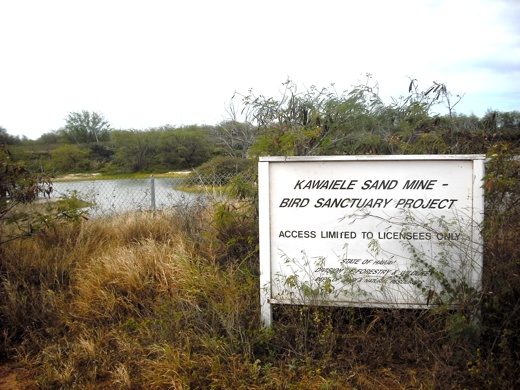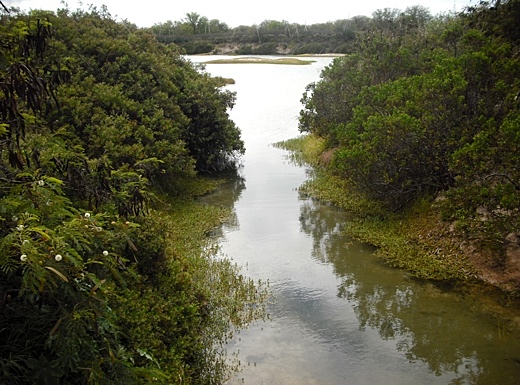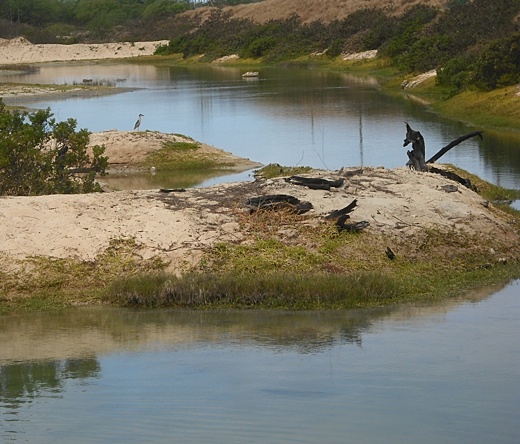SUBHEAD: The smell was overwhelming, the feces and dead shrimp attracted sharks, the canals were depleted, and it killed every single fish in the area.
By Juan Wilson on 19 March 2010 for Island Breath -
(http://islandbreath.blogspot.com/2010/03/kauai-shrimp-waste-dump.html)

Image above: Sign near entrance to Kawaiele wetland experiment managed by Hawaii DLNR. All photos by Juan Wilson 3/19/10
Rather than have an industrial shrimp farm that requires as much as 25 million gallons of noxious effluent flowing into the ocean in a day, why not expand the existing wetland sanctuary to handle a more natural way of breeding fish for the ocean's health and our own sustenance. A natural organic aquaculture would be a much better solution and return the Mana Plain back to the source of bird, plant and fish life that it once was.
As I have mentioned on this site before; the two greatest wetlands in the Hawaiian chain were both destroyed in the last century for money and power. One was Pearl Harbor - dredged out for the U.S. military. The other was the Mana Plain - filled in for industrial agriculture (and now the breeding ground for genetically modified crops).

Image above: Plants grow down into the brine wetland where fish are breeding.
The Kawaiele Sand Mine - Bird Sanctuary Project is only a few acres, but it demonstrates the beauty that was once adorned the western shores of Kauai. The Mana Plain had estuaries that teemed with fish and birds that allowed travel by canoe from Waimea past the town of Mana. Natural aquaculture is what we should be aspiring to. Restoring the wetlands and fishponds of the past would be a boon to the oceans. They would be breeding grounds for the reefs.

Image above: A Great Blue Heron hunts for fish in wetlands sanctuary.
he present strategy of industrial fish farming is destructive to local fisheries. Here is a quote from observations on shrimp farms on the Indian continent. See http://www.radford.edu/gmartin/Bangladesh%20photos%201.htm:
Video above: Dan Barber - How I fell in love with a fish farm. From (http://www.ted.com/talks/dan_barber_how_i_fell_in_love_with_a_fish.html)
Shrimp farm to dump waste in ocean By Coco Zickos on 19 March 2010 in Garden Island News - (http://thegardenisland.com/news/local/article_2385f08a-3331-11df-91b3-001cc4c03286.html)![]()
Image above: Sign near the entrance of the Sunrise Capital shrimp farm nest to the Kekaha Landfill.
All photos by Juan Wilson 3/19/10 Proposing to discharge up to 30 million gallons of wastewater effluent and treated shrimp remains into the ocean on a daily basis, Sunrise Capital has filed for a Draft National Pollutant Discharge Elimination permit with the state Department of Health, according to an e-mail from the DOH’s communications office Thursday.
Originally owned and operated by Ceatech USA, the Kekaha shrimp farm was acquired by Sunrise Capital in June 2005 and is currently operating at minimal capacity, said an e-mail from officials at the DOH’s Clean Water Branch. While this has “resulted in no discharge from the property” since 2004 after the “farm became infected with a shrimp virus,” Sunrise Capital seeks to increase its operating capacity which will likely generate a maximum of 23 million gallons of biological waste each day, according to CWB officials.
Messages left for Sunrise Capital Wednesday and Thursday were not returned. “The ocean is not a dump,” said environmental activist Dr. Gordon LaBedz of Surfrider Kaua‘i. Non-coastal shrimp farms can and do exist utilizing alternative methods of waste treatment and disposal, he said Thursday.

Image above: Pump aerator in middle of active shrimp basin lined with neoprene.
When asked if generating fuel from the waste could be a possibility, LaBedz said the amount of discharge would be insufficient to make it economically viable. “I’m not against the shrimp farm,” said community activist Bruce Pleas. However, when the farm was operating at full capacity from February 2000 to December 2003, the “disastrous effects” of the waste in the sea were monumental, he said. The smell was overwhelming, the feces and dead shrimp attracted sharks, the canals were depleted, and it killed every single fish in the area, he said. In addition, the dumping affected surf spots known as Kinikinis, Major’s Bay and Family Housing. The current can carry the waste which would allow it to “travel miles,” LaBedz said.
![]()
Image above: A 12" PVC discharge pipe from shrimp basin flows into ditch headed to ocean. Note dead plants in ditch coated with white accretion. By Juan Wilson on 19 March 2010 for Island Breath -
(http://islandbreath.blogspot.com/2010/03/kauai-shrimp-waste-dump.html)

Image above: Sign near entrance to Kawaiele wetland experiment managed by Hawaii DLNR. All photos by Juan Wilson 3/19/10
Rather than have an industrial shrimp farm that requires as much as 25 million gallons of noxious effluent flowing into the ocean in a day, why not expand the existing wetland sanctuary to handle a more natural way of breeding fish for the ocean's health and our own sustenance. A natural organic aquaculture would be a much better solution and return the Mana Plain back to the source of bird, plant and fish life that it once was.
As I have mentioned on this site before; the two greatest wetlands in the Hawaiian chain were both destroyed in the last century for money and power. One was Pearl Harbor - dredged out for the U.S. military. The other was the Mana Plain - filled in for industrial agriculture (and now the breeding ground for genetically modified crops).

Image above: Plants grow down into the brine wetland where fish are breeding.
The Kawaiele Sand Mine - Bird Sanctuary Project is only a few acres, but it demonstrates the beauty that was once adorned the western shores of Kauai. The Mana Plain had estuaries that teemed with fish and birds that allowed travel by canoe from Waimea past the town of Mana. Natural aquaculture is what we should be aspiring to. Restoring the wetlands and fishponds of the past would be a boon to the oceans. They would be breeding grounds for the reefs.

Image above: A Great Blue Heron hunts for fish in wetlands sanctuary.
he present strategy of industrial fish farming is destructive to local fisheries. Here is a quote from observations on shrimp farms on the Indian continent. See http://www.radford.edu/gmartin/Bangladesh%20photos%201.htm:
"The fishermen from a poor fishing village near Chittagong wade out to their boat when it comes back with its catch. The catches, they told us, are very slim compared to 15 years ago when there were plenty of fish. They rapidly walk with the fish in bamboo baskets resting on their shoulders the several kilometers to their village in order to try to sell it while it is still fresh." "In the same place where the poor fishermen were unloading their meager catch, the landscape was surreal, like a scene from some alien landscape. Giant earth moving machines were tearing at the tidal flats, creating vast holes and mountains of discarded mud. A commercial shrimp farm was being constructed." "These shrimp farms create food for export (not the local population) and destroy the mangrove coastal barriers that help prevent typhoon and storm damage and flooding on the land. These farms are being created all along the coasts of south India and Bangladesh. As usual, short term profits far outweigh the welfare of the local populations or future generations."Will military wastelands, genetically mutated grasslands and dead ocean reefs be our legacy on the Mana Plain? By the way, there is a rumor among people who know the harbors on Kauai that the PMRF is interested in dredging the Bird Sanctuary for a dock site of their own. For more about the effluent request by Sunrise Capitol, read on.
Video above: Dan Barber - How I fell in love with a fish farm. From (http://www.ted.com/talks/dan_barber_how_i_fell_in_love_with_a_fish.html)
Shrimp farm to dump waste in ocean By Coco Zickos on 19 March 2010 in Garden Island News - (http://thegardenisland.com/news/local/article_2385f08a-3331-11df-91b3-001cc4c03286.html)
Image above: Sign near the entrance of the Sunrise Capital shrimp farm nest to the Kekaha Landfill.
All photos by Juan Wilson 3/19/10 Proposing to discharge up to 30 million gallons of wastewater effluent and treated shrimp remains into the ocean on a daily basis, Sunrise Capital has filed for a Draft National Pollutant Discharge Elimination permit with the state Department of Health, according to an e-mail from the DOH’s communications office Thursday.
Originally owned and operated by Ceatech USA, the Kekaha shrimp farm was acquired by Sunrise Capital in June 2005 and is currently operating at minimal capacity, said an e-mail from officials at the DOH’s Clean Water Branch. While this has “resulted in no discharge from the property” since 2004 after the “farm became infected with a shrimp virus,” Sunrise Capital seeks to increase its operating capacity which will likely generate a maximum of 23 million gallons of biological waste each day, according to CWB officials.
Messages left for Sunrise Capital Wednesday and Thursday were not returned. “The ocean is not a dump,” said environmental activist Dr. Gordon LaBedz of Surfrider Kaua‘i. Non-coastal shrimp farms can and do exist utilizing alternative methods of waste treatment and disposal, he said Thursday.

Image above: Pump aerator in middle of active shrimp basin lined with neoprene.
When asked if generating fuel from the waste could be a possibility, LaBedz said the amount of discharge would be insufficient to make it economically viable. “I’m not against the shrimp farm,” said community activist Bruce Pleas. However, when the farm was operating at full capacity from February 2000 to December 2003, the “disastrous effects” of the waste in the sea were monumental, he said. The smell was overwhelming, the feces and dead shrimp attracted sharks, the canals were depleted, and it killed every single fish in the area, he said. In addition, the dumping affected surf spots known as Kinikinis, Major’s Bay and Family Housing. The current can carry the waste which would allow it to “travel miles,” LaBedz said.
“The nutrient levels in the immediate vicinity of the discharge into the receiving ocean waters are expected to be elevated from ambient conditions,” the e-mail from the CWB said. “However, the adjacent coastal ocean area is not expected to have any noticeable effect associated with the shrimp-farm discharge.”
“Water monitoring” which occurred while the shrimp farm was operating at full capacity prior to 2004 “indicated that the discharge from the facility did not affect the water quality of the ocean area,” nor did it impact any adjacent biological communities, the e-mail went on to say. In addition, Sunrise Capital will reportedly apply “numerous waste-minimization” efforts, according to the CWB.
And based upon the “company’s operating history which showed no evidence of negative environmental impact..,” officials at the CWB said they are supportive of the operation’s intent to dispose between 20 million and 30 million gallons of biological waste into the ocean. To review a copy of the NPDES application visit http://www.hawaii.gov/health/environmental/water/cleanwater/index.html. One may also acquire a copy at the Kaua‘i District DOH office located at 3040 ‘Umi St. in Lihu‘e.
Comments may be sent no later than April 10 to Clean Water Branch, Environmental Management Division, Department of Health, 919 Ala Moana Blvd., Room 301, Honolulu, Hawaii, 96814-4920. Objections and requests for a public hearing should also be sent to that address.
See also:
Ea O Ka Aina: Shrimp Effluent Permit 3/12/10
Island Breath: Kauai Shrimp to dump in ocean 8/21/06
Island Breath: Kauai's Crustacean Crisis 4/23/04 .
No comments :
Post a Comment